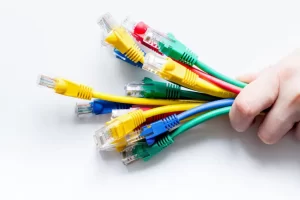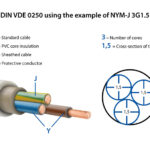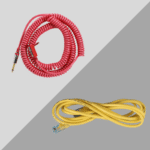What Does an Ethernet Cable Do?
An Ethernet cable plays a crucial role in connecting devices within a local area network (LAN), enabling them to communicate with one another and access the internet. Whether you're using a desktop computer, a laptop, a gaming console, or even a smart TV, the Ethernet cable helps establish a stable and reliable connection between these devices and your network. But what exactly does an Ethernet cable do? Let's dive into its main functions and why it’s essential for network communication.

what is an ethernet cable do
1. Facilitates Wired Networking
At its core, an Ethernet cable provides a wired connection between devices and a router, modem, or switch. It allows devices to connect to the internet and share data without relying on Wi-Fi. This wired connection offers a number of advantages, including reduced interference, more consistent speeds, and better security.
What it does: The Ethernet cable transmits data signals between devices in the network, enabling them to communicate, share files, and access the internet reliably.
2. Transmits Data at High Speeds
Ethernet cables are designed to support high-speed data transmission. Depending on the type of Ethernet cable (Cat5e, Cat6, Cat6a, Cat7, etc.), they can handle varying levels of bandwidth. For instance, Cat5e cables support speeds up to 1 Gbps, while Cat6 cables can handle speeds up to 10 Gbps over short distances. This makes Ethernet cables ideal for applications that demand fast internet speeds, like streaming HD videos, gaming, or video conferencing.
What it does: The Ethernet cable transmits large amounts of data efficiently, ensuring that your network operates smoothly and at the highest possible speed supported by your equipment.
3. Ensures Stable Connection
One of the most important things an Ethernet cable does is provide a stable, uninterrupted connection. Unlike Wi-Fi, which can be affected by distance, interference, and network congestion, a wired Ethernet connection remains consistent as long as the cable is plugged in and the devices are functioning properly.
What it does: The Ethernet cable ensures a reliable and steady internet connection with minimal disruptions or lag, especially in environments where a stable connection is critical, such as offices, gaming setups, or homes with multiple connected devices.
4. Supports Multiple Devices
Ethernet cables are often used in network switches or routers to connect multiple devices to the same network. This means you can connect several computers, printers, servers, or even smart devices through the same Ethernet cable network, ensuring that all devices can communicate with one another and access shared resources like files or printers.
What it does: The Ethernet cable allows multiple devices to communicate with each other on the same local area network (LAN) by linking them together through a network switch or router.
5. Improves Security
When compared to wireless connections, Ethernet cables provide a higher level of security. Since data is transmitted directly through a physical cable, it’s much harder for outsiders to intercept or hack into the network. This is why Ethernet is preferred in environments that require secure communication, like businesses, educational institutions, or government offices.
What it does: The Ethernet cable ensures that data transmitted across the network is more secure than through wireless methods, reducing the risk of unauthorized access or hacking.
6. Enables Direct Connection to the Internet
In many households and businesses, Ethernet cables directly connect devices like computers, printers, or TVs to the internet. By connecting a device to the router or modem using an Ethernet cable, users can access the internet without relying on Wi-Fi signals. This is especially useful for devices that require a fast, reliable connection, such as gaming consoles or streaming devices.
What it does: The Ethernet cable links devices directly to the internet via a wired connection, ensuring faster and more reliable internet access.
7. Supports Networked Devices and Services
In addition to connecting computers and internet devices, Ethernet cables also support networked devices such as network-attached storage (NAS), security cameras, and printers. These devices rely on Ethernet to communicate with each other over a local network, enabling shared services and resources.
What it does: The Ethernet cable enables communication between networked devices like storage systems and cameras, allowing them to exchange data seamlessly.
8. Used in Professional and Industrial Settings
In professional settings or industrial environments, Ethernet cables are used to ensure that business-critical applications, like file sharing, database access, and enterprise software run efficiently. Ethernet cables are more durable and less prone to interference than wireless connections, which is why they’re often used in environments where network reliability and performance are a top priority.
What it does: The Ethernet cable supports business operations by ensuring that critical systems are connected with minimal risk of connection failure or data loss.
Conclusion: What Does an Ethernet Cable Do?
An Ethernet cable is a critical component of wired networking, and it serves a number of essential purposes:
Facilitates wired networking by connecting devices directly to a router or modem.
Transmits data at high speeds, making it perfect for applications like streaming, gaming, and file transfers.
Ensures a stable, reliable connection, reducing disruptions and providing a steady internet experience.
Supports multiple devices in a network, allowing communication between computers, printers, and other networked devices.
Improves security by providing a safer, more secure connection compared to Wi-Fi.
Enables direct internet access for faster and more reliable internet connections.
Supports networked devices and shared resources, making it crucial for both home and business networks.
In short, an Ethernet cable connects devices, transmits data, ensures reliability, and enhances security, playing an integral role in any network. Whether you're setting up a home network, expanding a business network, or connecting a gaming console, Ethernet cables remain a staple for wired communication, delivering fast, secure, and dependable connectivity.





